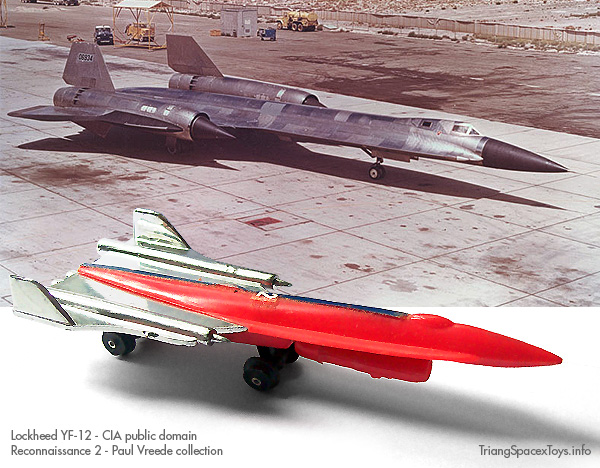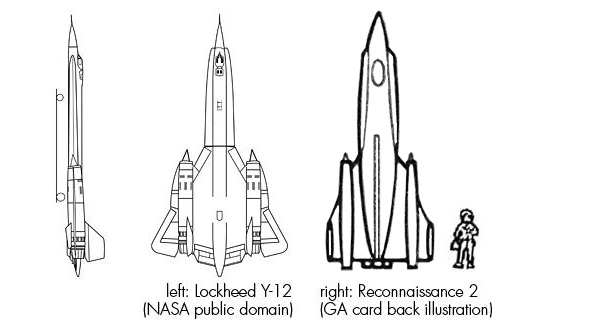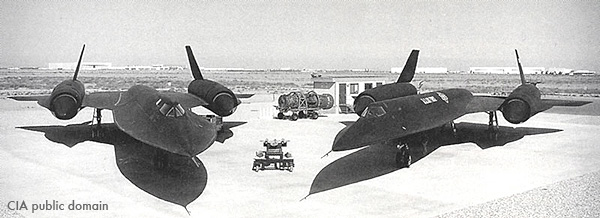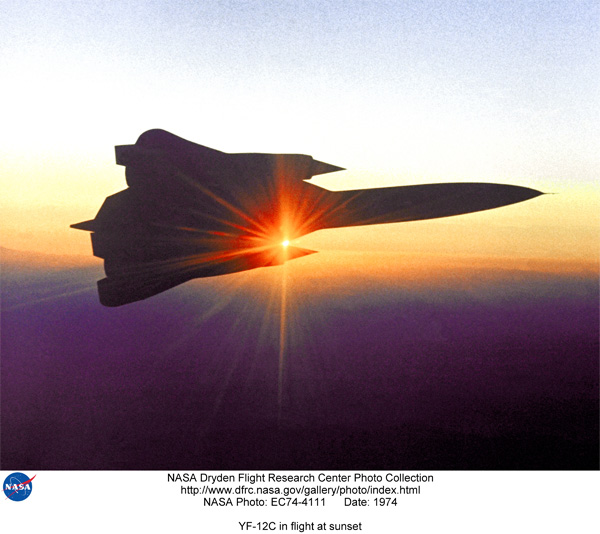
The Spacex Reconnaissance 2 is clearly based on the Lockheed YF-12 interceptor, albeit in rather simplified form. The tails have also been moved out to the end of the wings and a triple exhaust has been added to the end of the fuselage. These changes I suspect were to get the design away from the original ultra-high-speed jet and make it more believable as a spacecraft. Because the later SR-71 "Blackbird" reconnaissance version was also known to the public, chances are that the interceptor design and the reconnaissance rôle of its sibling were mixed up when this toy was made.

The Lockheed YF-12 was a US Air Force test version of the then-secret A-12 spy plane operated by the CIA under the code name 'Oxcart', and developed by Lockheed's legendary Skunk Works.* The A-12 had come about as a replacement for the older U-2 spy plane, after one had been shot down over the Soviet Union with pilot Gary Powers put on public display. Extremely high speed and altitude were the answers provided by the A-12; capable of speeds well in excess of Mach 3, it could 'simply' out-accelerate any missile trying to bring it down. Having the YF-12s out in the open served the CIA very well of course - any of their A-12s that might be discovered in flight would be mis-identified as a regular Air Force aircraft (with presumably a plausible excuse for what the thing could be doing above Soviet airspace :) Being a truly revolutionary aircraft (it immediately set world speed and altitude records, only surpassed by sibling SR-71s in following years), the YF-12s received wide coverage in the media after being officially announced in early 1964. Although the US Air Force did order 93 production aircraft, these interceptors intended for Home Defence were subsequently cancelled due to priorities for the war in Vietnam.

An original A-12 spy plane (right) and the later SR-71 (left)
But the Air Force had reconnaissance requirements of its own, which led to the YF-12 being developed into the (now much better-known) SR-71 "Blackbird". This first flew in December 1964 and was operational from 1966 to 1988, flying missions from Okinawa during the Vietnam war and subsequently also keeping an eye on Soviet fleet movements. Because parts weren't being produced anymore (meaning existing aircraft had to be cannibalised to keep others flying), the fact that it couldn't transmit information while underway (which lesser planes could) and with concerns over high operational costs, the SR-71s were withdrawn in 1988. But due to unease over the Middle East and North Korea, and especially due to lack of a real replacement, three SR-71s were brought back into service in 1993 to serve until 1998 (with NASA using two of these for another year).
As a fitting closure for this distinguished aircraft, the crew flying the last one from California to the Smithsonian Museum in Virginia set no less than four new speed records along the way!

External links open in new windows; just close them to get back here
*: The development of the A-12 is quite a story, which can be read on the CIA website. There is also mission information and even a flight manual for download!
Lockheed Martin have a page on the Blackbird, and there are also extensive articles on Wikipedia about the A-12, YF-12 and SR-71 as well as on Lockheed's Skunk Works.
Sploid has a blog page with lots of pictures and further links, including a brilliant account of what it's like to fly a Blackbird by Major Brian Shul.